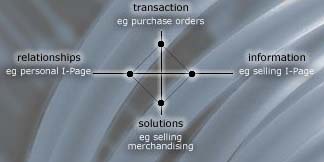| Lesson 13 | Levers of change for customer-centric value chains |
| Objective | Describe the Web technology infrastructure as the enabler of change. |
Four Change Levers of Technology Trends | 1. Transaction, 2. Information, 3. Solutions, 4. Relationships
Companies are using the four levers of change to accelerate development of customer-centric value chains.
The following diagram shows more about each lever of change.

- Transaction: e-Business is evolving from simple manual order entry into more robust, fully automated account management systems.
- Information: In the new world, companies will create a competitive advantage by providing the right information to the right people at the right time
- Solutions: Companies are moving from being reactive, and defined by sales of products, to providing proactive services and support
- Relationships: Managing relationships with end-users, channel, partners, suppliers and partners is becoming increasing critical for success in today's business environment. Ultimately, companies with deep relationship management systems will form solution networks to exchange data and extend their brands
E-business Examples of Companies using the levers of change
Cisco Systems: Fully integrated e-Business activities
- Relationship: Creating the virtual enterprise, e.g. integrated manufacturing and shipping into virtual network; standard account management suggesting area in need of improvement
- Information: ERP Systems Web-enabled to share information throughout the supply chain
- Solution: 10 people handle 70% of customer support via the Web, remaining 30% require 1,000 people on the phone
- Transaction: $5,000,000 transacted per day on Cisco Customers Online (CCO), Cisco's self-service model
Dell Computer: Pioneering B2B relationship management
- Relationship: 15,000 + premier pages drive corporate business and raise switching costs
- Information: Custom Web sites for 30 largest suppliers' real-time access, ordering through manufacturing
- Solution: Technical support online is the same information as technology personnel access. Build-your-own Dell pioneered custom assembly movement
- Transaction: Customer-facing services allow for increased ordering flexibility. Goal of 50% online sales, currently at 30% and rising
Federal Express: Creating inter-company integrated networks
- Relationship: Ships for 20,000 Web sites (UPS ships for 15,000)
- Information: Real-time, Web-based inventory tracking FedEx shipping module for SAP R/3 being developped with KPMG & SAP
- Solution: Outsourced assembly & distribution for customers e.g. HP & Fujitsu. Net Returns growing at a rate of 50% annually
- Transaction: 800 million online transactions a year
(CX) Customer Experience
Their experiences on this journey will strongly influence their attitudes which will help form their behaviors. Their behaviors will ultimately drive outcomes and is why (CX) Customer Experience has become so critical in modern commerce. At its simplest, CX is the set of perceptions a customer has with a company throughout their buying and owning interactions. It is obvious that positive customer experiences enable businesses to attract and retain more customers, sell more products, and do more business.
How does this relate to the supply chain? If a customer had a delivery or quality issue with a previous purchase from your company (experience), they might be reluctant to buy from you again, so the customer will therefore look for an alternative supplier, resulting in lower levels or repeat business and reduced sales which we will call the outcome. Historically, CX has been focused on sales, customer service, and marketing. But with the integration of supply chain into end-to-end business processes, it is apparent that the supply chain itself can have a significant impact on CX, both in a business to business (B2B) and a business to consumer (B2C) environment.
According to a report from KPMG, a Demand Driven supply chain approach can result in
How does this relate to the supply chain? If a customer had a delivery or quality issue with a previous purchase from your company (experience), they might be reluctant to buy from you again, so the customer will therefore look for an alternative supplier, resulting in lower levels or repeat business and reduced sales which we will call the outcome. Historically, CX has been focused on sales, customer service, and marketing. But with the integration of supply chain into end-to-end business processes, it is apparent that the supply chain itself can have a significant impact on CX, both in a business to business (B2B) and a business to consumer (B2C) environment.
According to a report from KPMG, a Demand Driven supply chain approach can result in
- a 1-4% improvement in sales,
- a 5-10% reduction in operating expenses and
- a 20-30% reduction in inventory.